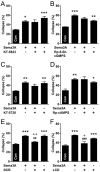Semaphorin 3A inhibits growth of adult sympathetic and parasympathetic neurones via distinct cyclic nucleotide signalling pathways
- PMID: 21054346
- PMCID: PMC3051381
- DOI: 10.1111/j.1476-5381.2010.01108.x
Semaphorin 3A inhibits growth of adult sympathetic and parasympathetic neurones via distinct cyclic nucleotide signalling pathways
Abstract
Background and purpose: Semaphorin 3A (Sema3A) is an important secreted repulsive guidance factor for many developing neurones. Sema3A continues to be expressed in adulthood, and expression of its receptor, neuropilin-1 (Nrp-1), can be altered by nerve injury. Autonomic neurones innervating the pelvic viscera are particularly susceptible to damage during pelvic surgical procedures, and failure to regenerate or aberrant growth of sympathetic and parasympathetic nerves lead to organ dysfunction. However, it is not known if adult pelvic neurones are potential targets for Sema3A.
Experimental approach: The effects of Sema3A and activation or inhibition of cyclic nucleotide signalling were assessed in adult rat pelvic ganglion neurones in culture using a growth cone collapse assay.
Key results: Sema3A caused growth cone collapse in both parasympathetic and sympathetic neurones expressing Nrp-1. However, the effect of Sema3A was mediated by distinct cyclic nucleotide signalling pathways in each neurone type. In parasympathetic neurones, cAMP and downstream activation of protein kinase A were required for growth cone collapse. In sympathetic neurones, cGMP was required for Sema3A-induced collapse; cAMP can also cause collapse but was not required. Sema3A-mediated, cGMP-dependent collapse in sympathetic neurones may require activation of cyclic nucleotide-gated ion channels (CNGCs).
Conclusions and implications: We propose that Sema3A is an important guidance factor for adult pelvic autonomic neurones, and that manipulation of their distinct signalling mechanisms could potentially promote functional selective regeneration or attenuate aberrant growth. To our knowledge, this is also the first study to implicate CNGCs in regulating growth cone dynamics of adult neurones.
© 2011 The Authors. British Journal of Pharmacology © 2011 The British Pharmacological Society.
Figures







Comment in
-
Highlights in basic autonomic neuroscience: Semaphorins in the remodeling of autonomic innervation.Auton Neurosci. 2013 Mar;174(1-2):1-4. doi: 10.1016/j.autneu.2013.01.002. Epub 2013 Feb 8. Auton Neurosci. 2013. PMID: 23395616
Similar articles
-
Nerve growth factor and semaphorin 3A signaling pathways interact in regulating sensory neuronal growth cone motility.J Neurosci. 2002 Aug 1;22(15):6659-69. doi: 10.1523/JNEUROSCI.22-15-06659.2002. J Neurosci. 2002. PMID: 12151545 Free PMC article.
-
Cyclic GMP-gated CNG channels function in Sema3A-induced growth cone repulsion.Neuron. 2008 Jun 12;58(5):694-707. doi: 10.1016/j.neuron.2008.03.017. Neuron. 2008. PMID: 18549782
-
Nerve growth factor, glial cell line-derived neurotrophic factor and neurturin prevent semaphorin 3A-mediated growth cone collapse in adult sensory neurons.Neuroscience. 2006 Oct 13;142(2):369-79. doi: 10.1016/j.neuroscience.2006.06.031. Epub 2006 Jul 28. Neuroscience. 2006. PMID: 16876331
-
Molecular basis of semaphorin-mediated axon guidance.J Neurobiol. 2000 Aug;44(2):219-29. doi: 10.1002/1097-4695(200008)44:2<219::aid-neu11>3.0.co;2-w. J Neurobiol. 2000. PMID: 10934324 Review.
-
Growth cones integrate signaling from multiple guidance cues.J Histochem Cytochem. 2003 Apr;51(4):435-44. doi: 10.1177/002215540305100405. J Histochem Cytochem. 2003. PMID: 12642622 Review.
Cited by
-
Fidgetin-like 2 negatively regulates axonal growth and can be targeted to promote functional nerve regeneration.JCI Insight. 2021 May 10;6(9):e138484. doi: 10.1172/jci.insight.138484. JCI Insight. 2021. PMID: 33872220 Free PMC article.
-
Inhibition of neuronal apoptosis and axonal regression ameliorates sympathetic atrophy and hemodynamic alterations in portal hypertensive rats.PLoS One. 2014 Jan 6;9(1):e84374. doi: 10.1371/journal.pone.0084374. eCollection 2014. PLoS One. 2014. PMID: 24400086 Free PMC article.
-
Culture of major pelvic ganglion neurons from adult rat.Cytotechnology. 2013 Aug;65(4):663-9. doi: 10.1007/s10616-012-9515-5. Epub 2013 Jan 3. Cytotechnology. 2013. PMID: 23283520 Free PMC article.
-
Insight into Lotusine and Puerarin in Repairing Alcohol-Induced Metabolic Disorder Based on UPLC-MS/MS.Int J Mol Sci. 2022 Sep 8;23(18):10385. doi: 10.3390/ijms231810385. Int J Mol Sci. 2022. PMID: 36142292 Free PMC article.
-
Notochordal cell-derived therapeutic strategies for discogenic back pain.Global Spine J. 2013 Jun;3(3):201-18. doi: 10.1055/s-0033-1350053. Epub 2013 Jul 12. Global Spine J. 2013. PMID: 24436871 Free PMC article. Review.
References
-
- Anderson RB, Bergner AJ, Taniguchi M, Fujisawa H, Forrai A, Robb L, et al. Effects of different regions of the developing gut on the migration of enteric neural crest-derived cells: a role for Sema3A, but not Sema3F. Dev Biol. 2007;305:287–299. - PubMed
-
- Behar O, Golden JA, Mashimo H, Schoen FJ, Fishman MC. Semaphorin III is needed for normal patterning and growth of nerves, bones and heart. Nature. 1996;383:525–528. - PubMed
-
- Dail WG, Manzanares K, Moll MA, Minorsky N. The hypogastric nerve innervates a population of penile neurons in the pelvic plexus. Neuroscience. 1985;16:1041–1046. - PubMed
Publication types
MeSH terms
Substances
LinkOut - more resources
Full Text Sources
Miscellaneous

